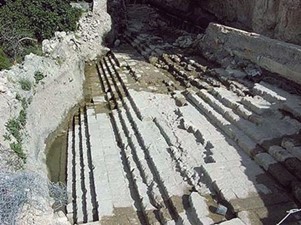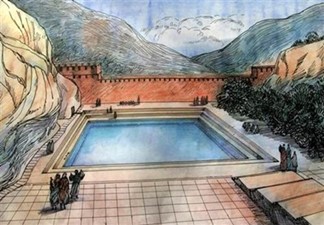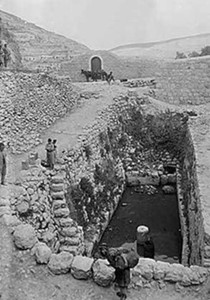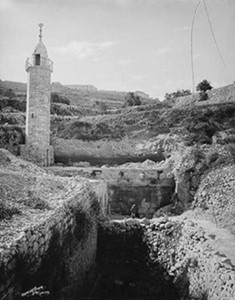Print Article
Author's Bias | Interpretation: conservative | Inclination: dispensational | Seminary: none
 © Biblical Archaeology Review
|
 Illustration including the Pilgrimage Road steps
© NBC News |
While repairing a sewer in June 2004 near an area known as the King's Garden, excavators uncovered a couple
stone steps. Recognizing that the steps probably led to down to the Pool of Siloam during the Second Temple Period,
Israeli archaeologists Ronny Reich and Eli Shukron took over the excavation and proceeded to expose and widen the
entire length of stairs.
The stone staircase had three sections - each section had five stairs and a narrow esplanade
landing. Archaeologists believe that all of the stairs were submerged when the pool was full, and the esplanade
allowed people to stand and linger.
Measuring some 225 feet, the end of the stairs each had a stepped corner, which indicated that
the pool had at least stairs on three sides. Because most of the area was on private property, archaeologists were
unable to determine the shape or how large the pool was.
The steps had two different types of construction:
At its deepest layer, the steps were made of plaster, and remarkably four coins were found in
the plaster! The coins were of Alexander Jannaeus and dated the construction sometime around 103-76 B.C.
At a later time, the plaster stairs were faced with stone steps.
 A 1920s photo of the Byzantine
Pool of Siloam
|
 Taken in 1898, a photo of the
opposite view of the Byzantine Pool
of Siloam shows the minaret and
remains of the mosque |
Discovered at one end of the pool were two types of artifacts: Second Temple pottery shards and a dozen coins
that were dated firmly to the First Jewish Revolt (66-70 A.D.). Both artifacts ceased in circulation when the
Romans destroyed Jerusalem; thus, archaeologists know when the Pool of Siloam was abandoned. Over time, mud
accumulated until the pool disappeared, and in some places, nearly under ten feet of mud.
While this discovery is certainly the Pool of Siloam that existed during the time of Jesus and mentioned in
John 9, archaeologists are uncertain if this is the original Pool
of Siloam built by Hezekiah (2 Ki 20:20).
One piece of evidence supportive of the location being the same or close to Hezekiah's original
pool is that the much older Siloam channel (possibly mentioned by Isaiah
[Isa 8:5] and blocked
[2 Chron 32:2-4, 30]) empties into this Second Temple period
pool.
However, the uncertainty remains, because after the Exile, Nehemiah speaks of additional work
made to Hezekiah's pool (Neh 3:15).
And much later, midway through the fifth century (around 440 A.D.), Empress Eudocia and Byzantine
Christians, believing that the Pool of Siloam was located at the exit of Hezekiah's Tunnel, sought to preserve it
by building a stone wall around it, and a church was built nearby to commemorate Jesus' healing of the blind man.
During the Middle Ages, the church was destroyed and replaced by a mosque. Although this late date always posed
a problem, the Byzantine pool was thought to be the Pool of Siloam until this recent discovery.
The discovery of the Second Temple period Pool of Siloam provides a better understanding and context to John's
recording of Jesus healing the blind man (John 9:1-12). The size
of the pool is more appropriate for a large number of people passing through, and it is well situated at the foot
of the Pilgrimage Road leading up to the Temple.
But how was this pool used? If this was a miqveh, ritual bathing was only acceptable in the nude.
Thus, much remains to be excavated and researched.
References:
1. Shanks H, "The Siloam Pool Where Jesus Cured the Blind Man" in Biblical Archaeology Review, vol. 31, no. 5 (Sept / Oct 2005).
2. From the website BiblePlaces.com: The Pool of Siloam Revealed
Copyright ©
2018
Helpmewithbiblestudy.org. All rights to this material are reserved. We encourage you to print the material for personal and
non-profit use or link to this site. If you find this article to be a blessing, please share the link so that it may rise in
search engine rankings.